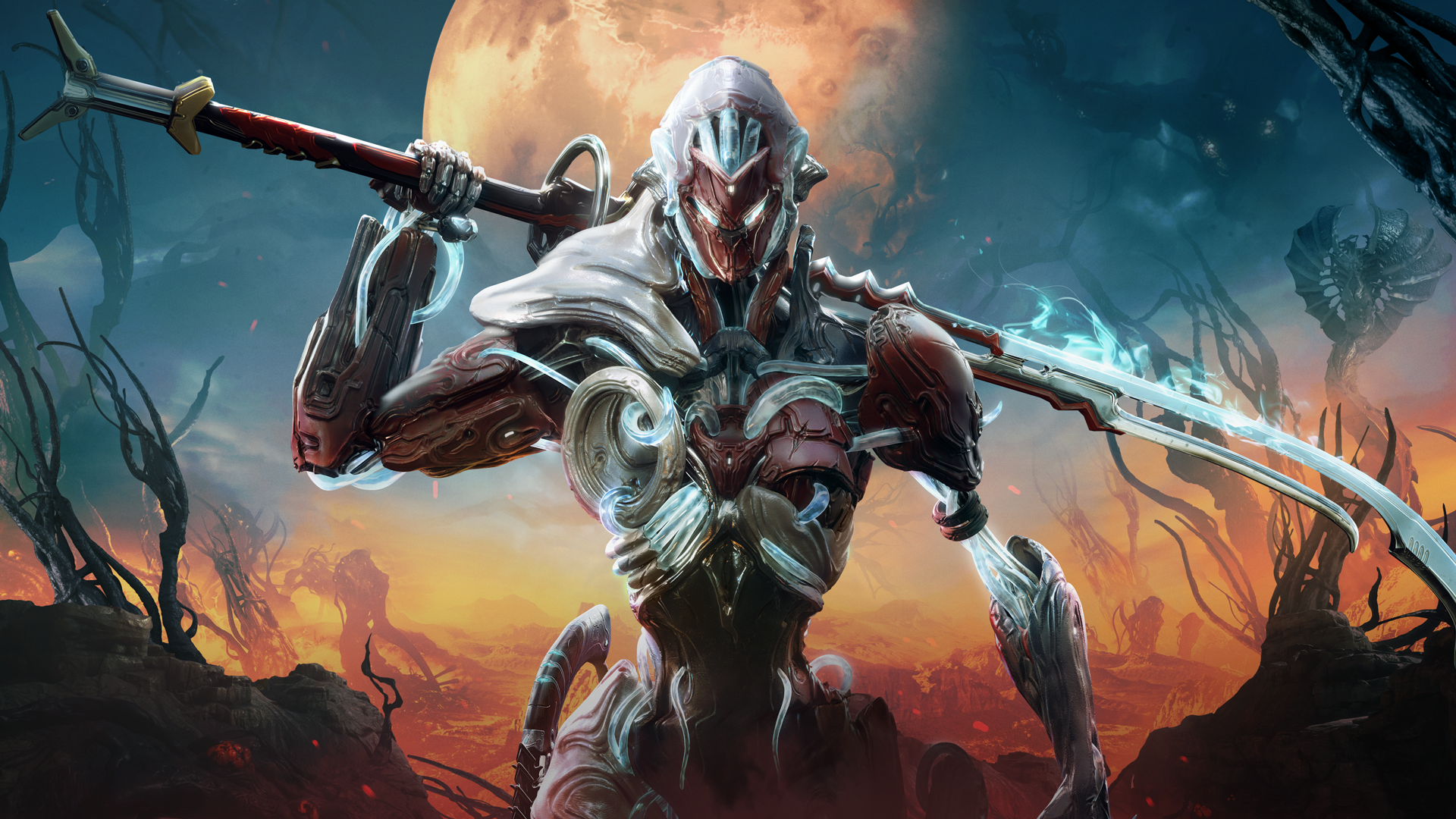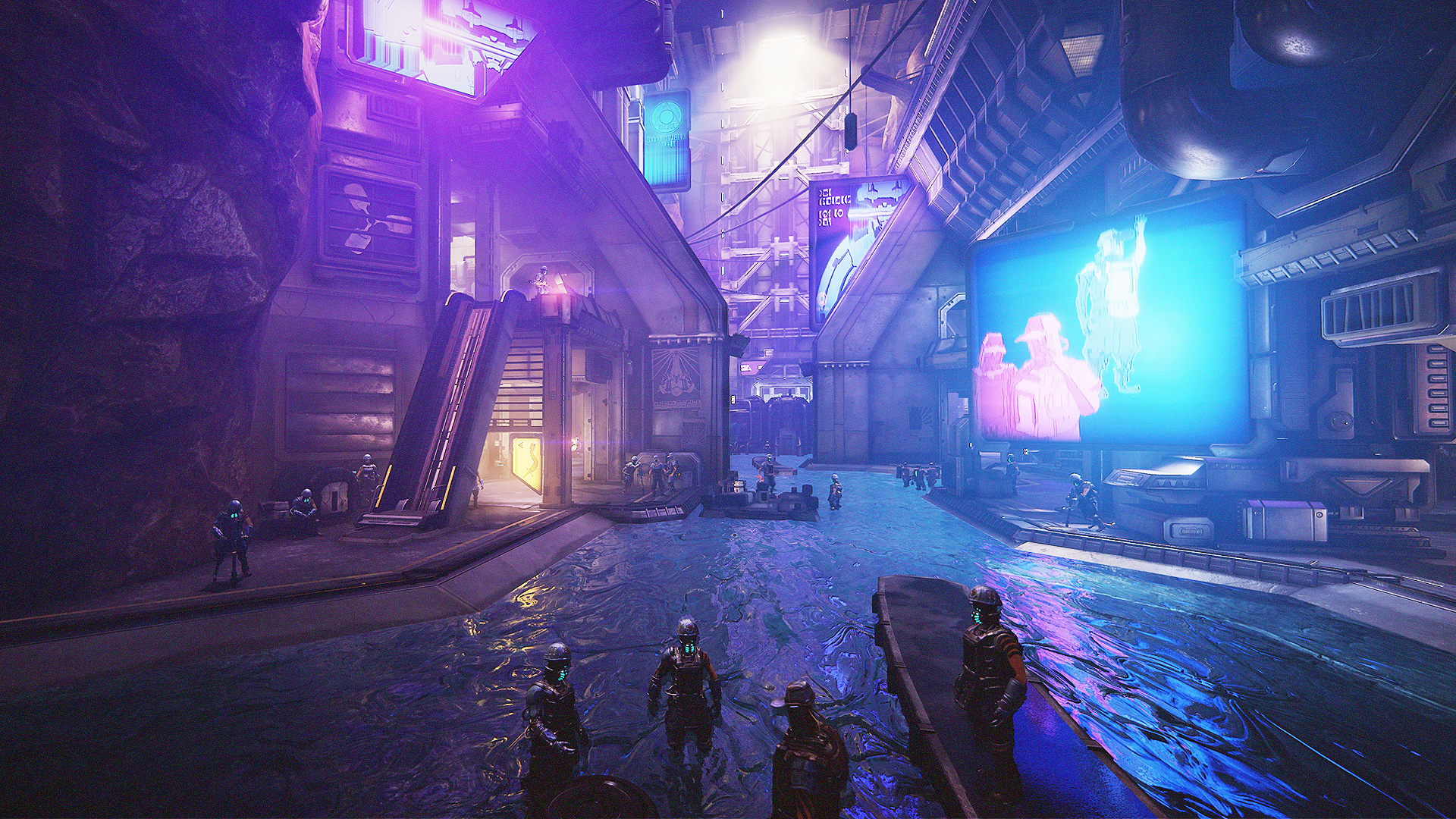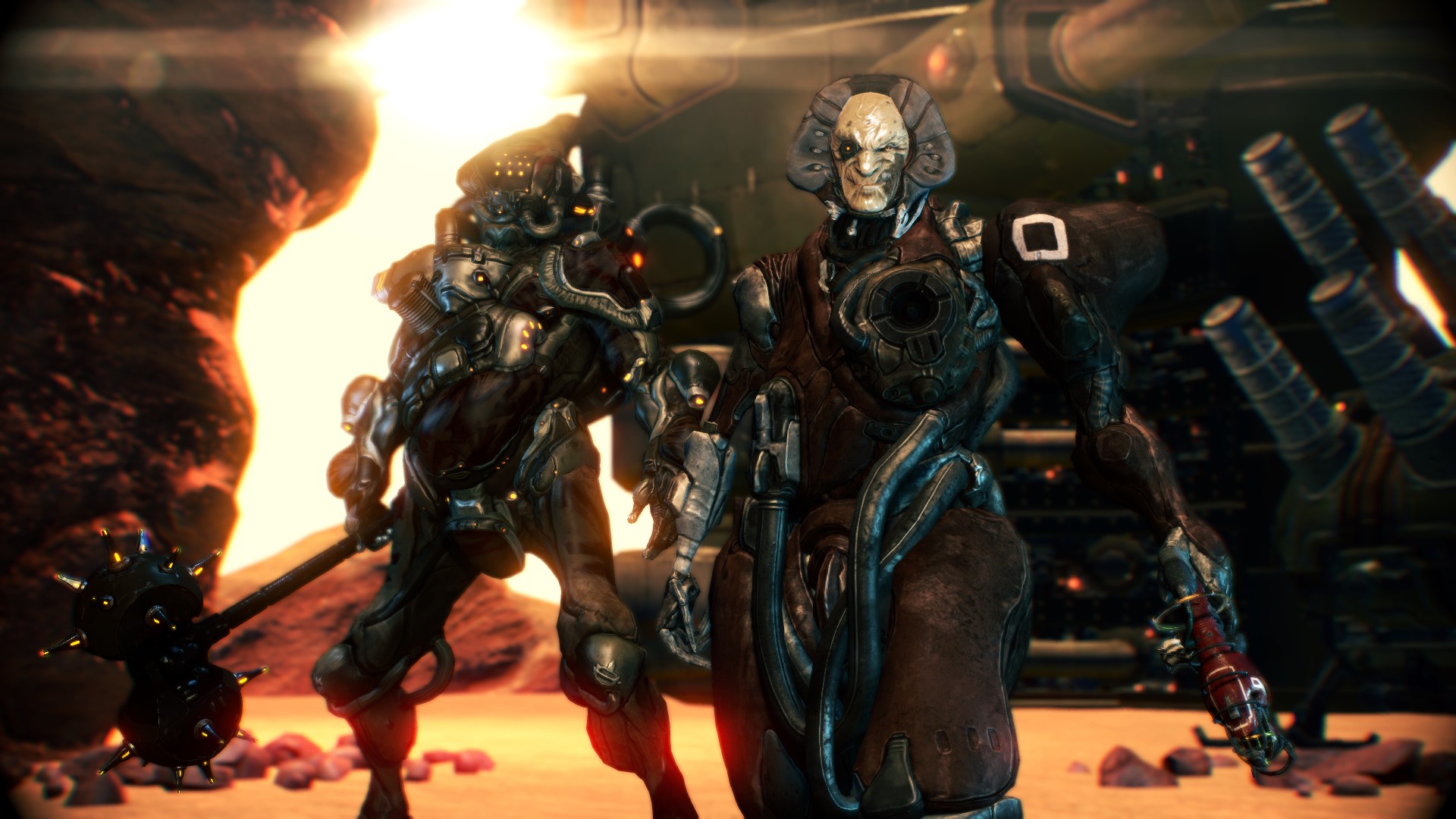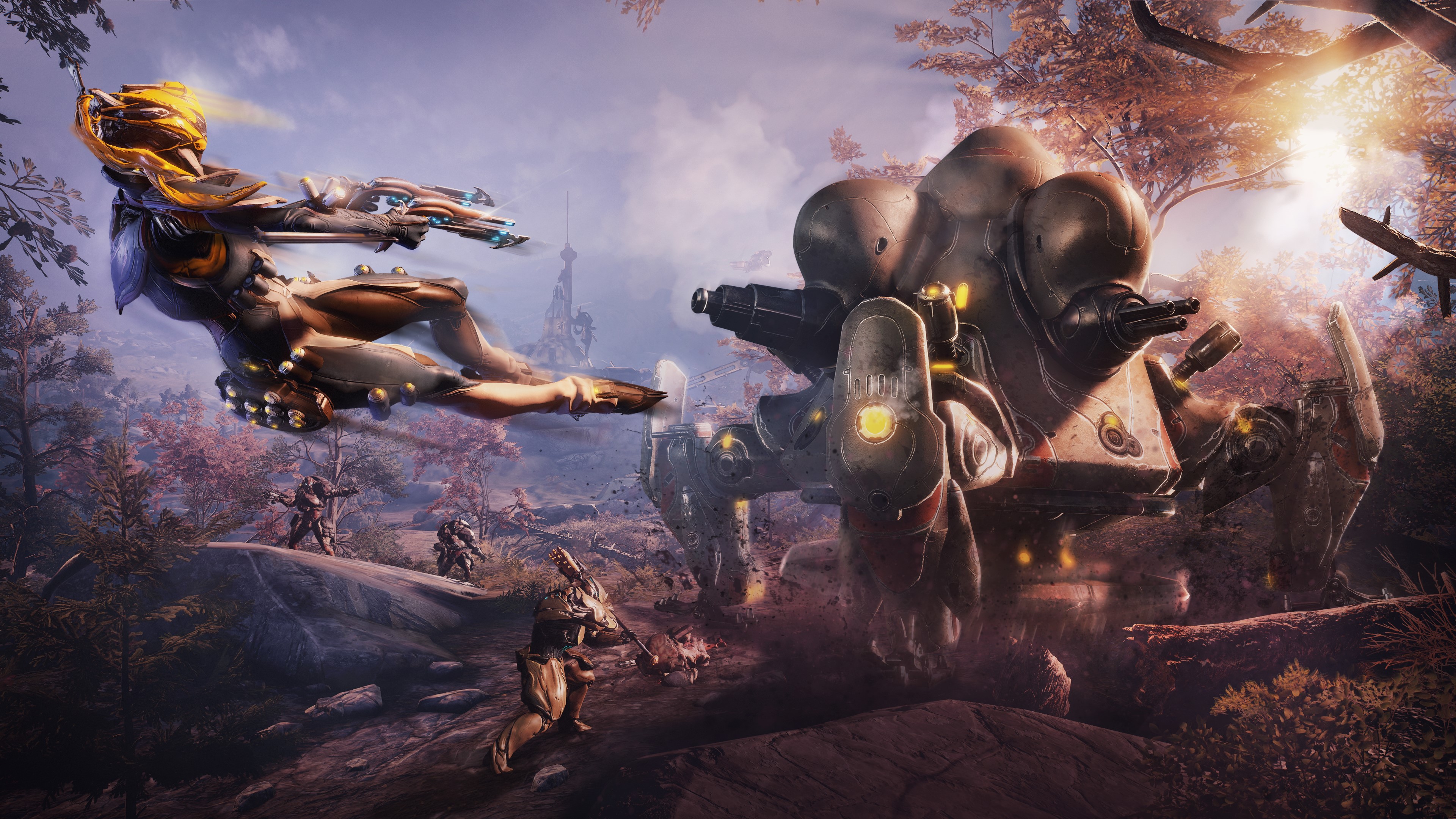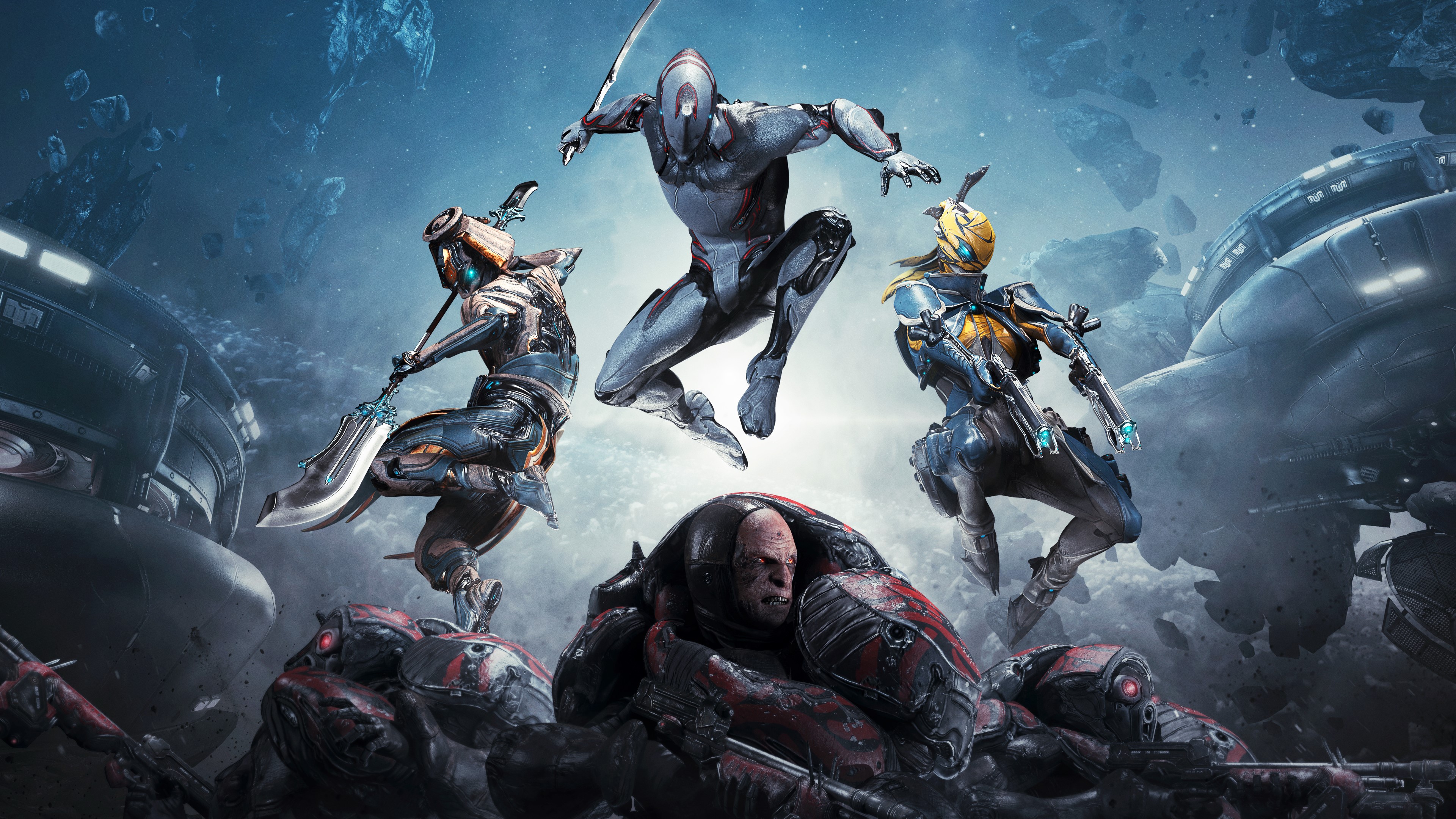
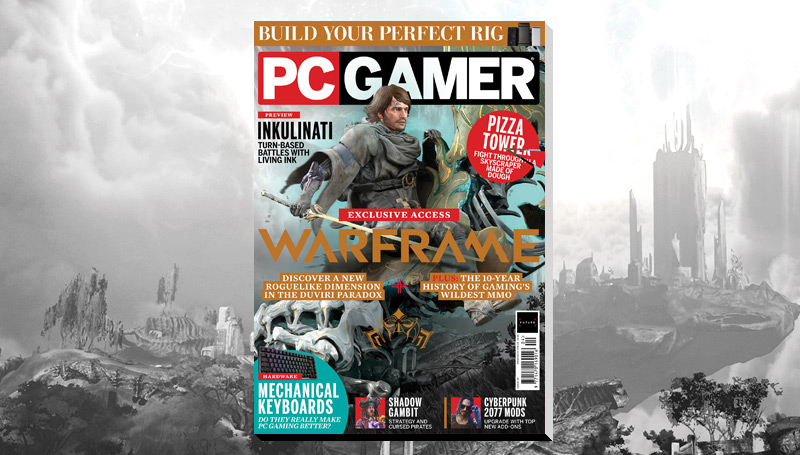
This article first appeared in PC Gamer magazine issue 381 in March 2023, featuring more even more exclusive interview content, original concept art, and more. You can still pick up a copy direct from us. Every month we run exclusive features exploring the world of PC gaming—from behind-the-scenes previews, to incredible community stories, to fascinating interviews, and more.
Warframe is big. Both in its success, and in its scale. It's a vast action game that is as much about space combat, apartment decorating, pet training, fishing, hover surfing, mech fighting and open world exploration, as it is the central ninja combat that defined its debut. It's now ten years old and still a roaring success, a feat few of its service game and MMO peers can boast. Like its Tenno, Warframe is an underdog that prevailed against the odds.
Developer Digital Extremes is itself almost 30 years old, and spent the 2000s doing work-for-hire, creating licensed games for a variety of clients. The Darkness, Star Trek, Dungeons & Dragons... the studio survived by taking whatever work it could. But there was always one dream project, a little sci-fi game the team hoped to one day get off the ground. I was curious where the idea came from. "Like every game dev in [2004] they played Resident Evil 4 and they wanted to make their own version of it," says Steve Sinclair, former creative director on Warframe, before he and fellow director Geoff Crookes both burst into laughter. Every answer they give is with a smile, and you get the sense they're two guys who never take themselves too seriously. But there is some truth to their joke.
"Everyone rediscovered third- person," Sinclair explains, pointing to Resident Evil 4's success and games like Gears of War, following the era of first-person dominance, making their project seem more viable. "[Warframe] has its roots in what we call the sci-fi version of Dark Sector."
It was this version they pitched to numerous publishers in what is now dubbed the 'rejection tour'. "I was on the road pitching for a year, all over the world with a little cube PC that would always get scrubbed by the bomb squads." Despite the effort, publishers weren't interested. "Sci-fi was dead," they were told. "So like a really confident artist... I completely compromised our vision for it [laughs]."
Dark Sector was transformed into a modern-set story. Biomechanical suits became a mysterious 'technocyte' virus, and the player character's space ninja became a CIA agent. "I remember Steve had to sit me down," Crookes recounts. "You were so sincere, like, 'Geoff I think we need to make a game with a helicopter.'" Dark Sector released in 2008 to mixed reviews.
It's clear though that the time following this was difficult for the company, as a seismic shift swept the industry around 2010. "The bottom fell out of all the [mid-sized] developers," CEO Sheldon Carter says of the time, as publishers shifted focus to huge, triple-A projects. "I'm sure everyone you've talked to has told you the same story with this, that we were really in trouble and this was our last shot."
Everyone did tell the same story. They'd had to lay off about a third of their staff. There was time and budget for one last project. If it failed, Digital Extremes was done. They decided that, if this was it, they were going to try make the one game they had always wanted to. So, in 2012, production on Warframe began.
Keep up to date with the most important stories and the best deals, as picked by the PC Gamer team.
It couldn't have been a bigger gamble. And they wanted to make it free-to-play. This was ten years ago, long before other big titles had planted their flag there. "I remember when we launched as a PS4 title, that Sony had these internal conferences," Sinclair recalls. "There was a round table on free-to-play and there were two people in the audience. Seven hundred chairs, empty. There's five devs... Orcs Must Die, me... some other hopeful people and just two people in the audience. Nobody was into it."
Not only was free-to-play a difficult pitch to gamers at a time when the term was synonymous with mobile phone shovelware, it was a hard sell to Digital Extremes' own team. Sinclair tells me that even their own staff were "leery" of what free-to- play meant. Still unable to secure a publisher, it was decided that Digital Extremes would publish Warframe itself. A decision that, quite literally, paid off, according to Sinclair: "Whatever money we made went back into the game and back into the studio. Instead of that cycle you're in with a publisher where you get all these advances and you hope the game makes the money back but you don't know for six months if that's the case. You go through these boom and bust cycles."
Corpus pocus
I ran into the programmers' stand-up meeting and I said, 'We made money!'... they all turned and looked at me in disbelief.
Steve Sinclair, former creative director
Sinclair fondly remembers when they had their first day of profit. "I'm going to slaughter the exact figure but I believe it was $1,548. I ran into the programmers' stand-up meeting and I said, 'We made money!'... they all turned and looked at me in disbelief." Warframe, released as a closed then open beta, came with benefits. "Us making it real and putting it out there, [got us] immediate feedback from players," Crookes explains, where previously the only feedback they were getting was from publishers, whose main interest was trying to get the studio to do more for less. "Immediate feedback from players, positive feedback but also ideas on what they would like... we just had this boom of investment from the development team, to get in there and build this game around the player-base."
It wasn't all smooth sailing. Sinclair recounts an especially disastrous moment for the game... on Christmas day. "People were losing XP. End of a mission, they weren't getting the right experience points... we're into the afternoon. Instead of having eggnog, I'm trying to figure this out. So I say, I'm going to build myself a test environment. I'll clear all the accounts, start myself a new account and I'll see what my experience points [are], log the data. Well, I was still connected to the production server when I cleared all the accounts. So Christmas day... I erased everyone's Warframe accounts." Sinclair and Crookes can find the humour in moments like that. "I called Glen, who's our tech director, and I said, 'Glen, I just deleted the entire database,' and he just started laughing. You know, you can't be mad, right? You just have to laugh." Thankfully their backups worked averting the crisis.
Nurturing a community is tricky, especially in unproven waters. Though it never stops being a challenge, according to former community director Rebecca Ford. "Every emotion on the spectrum has made up some part of the community journey," she says. "I have just tried over all of these years to understand what people like about Warframe and do more of that. Then when we surprise them, let them know we're sometimes going to try different things. And the faster we fail, the easier we can move on."
Part of building a healthy community has no doubt been its free-to-play model. Almost everything in the game can be earned through play, without spending a penny.
Given that model and its success, I asked Carter what the key to making good free-to-play is. "It's still games like we've always made, at least for my career. You have to start first with the fun and the spirit of the game. What's your narrative hook? What's your gameplay hook? You can always keep monetisation in mind but it has to be second." For Carter, their games have to be worth playing forever. "We want it to be something you're gonna be proud of, to talk to your friends about it. Come to Tennocon and chat with other people who are into it."
Over the years one of the most remarkable things about Warframe, as someone who has played it from the early days in 2013 to the present, is how a really compelling narrative slowly emerged from its shooting and looting. Talk to any fan and they will cite story moments in quests like The War Within as the highlights of the entire game. And everyone remembers the Second Dream twist, which reframes the whole game's narrative.
Lost in space
It wasn't like Lost, we weren't making it up as we going along... I'm kidding, it was that.
Steve Sinclair, former creative director
In hindsight it looks carefully planned, but depending on who you ask, a lot of it seems to have emerged over time. "My recollection and this is my recollection only..." Ford begins telling me, amused at what are sure to be discrepancies between people's accounts. "Is that Operators and stuff weren't a thing early on in Warframe." She recalls that the earliest concepts of the Operators didn't come about until about two years after the game's launch, laying the groundwork for the game's first big audacious twist in The Second Dream.
"It wasn't like Lost, we weren't making it up as we going along... I'm kidding, it was that," Sinclair jests. Though he says they certainly did have some ideas even early on for the game's themes like the duality of the Tenno as well as the Second Dream twist. Crookes agrees.
"There was a foundation there that [Steve and I] would talk about. It's funny, some players would pick up on these little seeds we were planting." Yet The Second Dream was a contentious idea in the studio, Sinclair recalls that some in the studio found the twist "scandalous". "We were scared to do it," Crookes admits. "We were so excited to do it but we were nervous cause we're like, 'Is this gonna turn off a majority of the players? Is this even why they play this game?'"
Playing Warframe now, you can arrive at a quest like The Second Dream much sooner—an acknowledgement that it really became what a lot of players were invested in. "It even had this unexpected consequence or benefit of, we saw a lot of players come back," Crookes says. "We saw a lot of accounts get reactivated when The Second Dream started getting the word out. That motivated us, excited us and got us to invest in that kind of worldbuilding."
And as [The Second Dream] was the first time, between Steve and Geoff and the leadership team, they realised that we needed to have good narrative," Ford says, of how it redefined the game. "Like, action gameplay is great, but it's not very emotional, and all of them, as long as I've known them, have cared so much about the art of storytelling. They realised very early on that we had an opportunity to tell a story."
For an action-driven service game like Warframe, a balance does have to be struck, as Sinclair explains. "There's always this argument as a game designer, the purity versus the story versus the world. Warframe has definitely been experimental for us in toying with those things, getting burned and then having some success as well." Despite those wins, nobody is more critical of their work than the developers. Sinclair feels like The New War had its issues. "Something like The New War, I possibly took it too far, where that was just so much work. So much animation. Ideally, I could be a bit lighter touch on the size of those scripts. It's been a really interesting learning exercise. The quality of the writing, obviously we grew a writing staff, the quality of the VO, the acting, just watching those rise through the life of the project."
They were like, 'Can you do a British accent? Can you be like the empress at the beginning of Dune?' I was like, 'No? I can be a Canadian?'
Rebecca Ford, creative director
Rebecca Ford, in many ways, has been closer to the story than most, having lent her own voice to the Lotus, the player character's mentor, who guides them throughout the entire game. Joining the company from a local MIT programme as an intern, how'd she end up in the role? "It's because we had no money," she admits frankly. "And I was like one of four women on the team at the time." She was willing to give it a try, but found there were certain things she couldn't do in place of a professional voice actor. "I remember we had to watch David Lynch's Dune and they were like, 'Can you do a British accent? Can you be like the empress at the beginning of Dune?' I was like, 'No? I can be a Canadian?'"
But for Ford, it's not a simple relationship she has with that character. "I was 21 when I recorded my first [lines] for Lotus. I was a young lady. Now I'm ten-plus years older... I love her, like Lotus is in Smash, right? She's a spirit in Super Smash. I feel like in many ways she's everything I'm not. I love her as a character, I just wish I could do better for her."
The future of Warframe's story is a bright one but also one full of mystery. There are plenty of hints about what's coming and yet it feels like the game could go anywhere. How do you steer a project like that? "The one thing I have learned that's been the most precious for me to always look in on," Ford says. "Is working on a creative team of people that are experts in their field, [is] a comforting truth when you can tell a story together and for me, it's about what story we're telling next and I am very excited to get the Duviri chapter out into the world then see where it goes from there."
So what lies ahead for Warframe? Exactly a year before the time we spoke, Ford was made creative director. Something that felt like a natural fit to nearly everyone but herself. "I didn't ask, I didn't apply, we were looking internally at a leadership level," she explains. "I hadn't even considered myself at all. Truly, truly, did not think I had it."
Sinclair, Crookes and Carter thought Ford was the obvious choice and essential in keeping Digital Extremes healthy. "If my old ass is stuck in whatever position, other people don't get a chance to grow and try out things," Sinclair says. Starting as one of a tiny handful of women at the studio, Ford is now proud of how things have improved. "We've hired about 60-plus women, which is amazing for me to see."
A new quest
Taking over a "ten year old pseudo-MMO that was basically crowdfunded from the ground up" and taking it into a bold new future is something both exciting and terrifying for Ford. "I want to do a good job but I don't know if I know how. So I just need to trust myself, trust my team and trust the community. We'll figure it out together. They'll tell me if I'm wrong. I'm not surrounded by people who are like, 'OK boss, let's do that idea.'"
And while Warframe is now in exciting new hands, its old creative heads are embarking on a new journey with the recently announced Soulframe. "I'm an old Star Trek guy, the mirror universe, the Terran Empire. So [Soulframe] isn't the opposite of Warframe but some things are inverted," Sinclair says. "Warframe is crazy fast, high agility, Soulframe is a bit slower, more casual. Warframe is about shooting, Soulframe is about melee more. But there's a lot of shared DNA. With Soulframe I want it to feel punk rock a bit, you know? I wanna do something with only two people in the audience initially."
It's a tall order, with Warframe's success shaping the industry in a big way. They struggled to convince their own team with Warframe, now they have people knocking on their door to experience working on a service game. "If [Sinclair] was doing that same presentation this year at an E3, there'd be more than two people in the crowd," Crookes states. "It's a much different development time to do this than it was when we did Warframe. I think Warframe shipped with eight warframes? And two small art sets? We're going to be required to ship more when we launch Soulframe."
Tenno years older
"It was something they all wanted, that they had no idea they were going to get."
Sheldon Carter, CEO
For a game and developer journey as storied as Warframe's and Digital Extreme's, looking back now, what were the highlights for the team?
There are a couple for Carter, but a big one was the unveiling of Plains of Eidolon at Tennocon, Warframe's first open world. "In front of that crowd, hearing them erupt with their joy. I'm just a game developer, but now I get why Madonna is going back on world tour again to stand in front of people." The surprise is a key part, he tells me. "It was something they all wanted, that they had no idea they were going to get."
"I have this very strong memory from when The Second Dream came out," Sinclair begins, telling me about a moment he won't forget. "We were getting reactions and watching people play it and this one fan just broke down and bawled at the end. This was playing in our board room to our admin, James who started the company, who is very aloof, not very emotionally available, and the tears were rolling silently down his cheeks as he's watching this player just losing their mind and gush with love about what an experience it had been."
Ford's is the moment she got offered the creative director role, a huge achievement for someone who started at the company as an intern and now gets to steer the ship. "I feel like never again in my lifetime will I get an opportunity to tell someone our next creative choice and see it all come together, so perfectly, that I just want to make the most of it. I'm not gonna stare too close at the fear part of me, that knows how difficult it is to make games." As always with Ford, it's onwards and upwards. "I think it's gonna be our best year yet."

